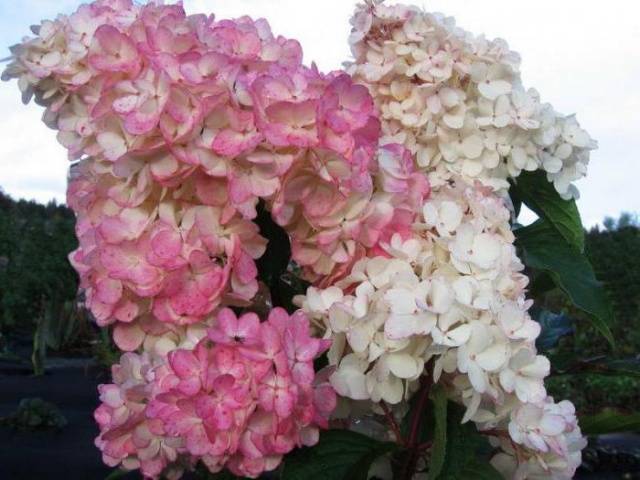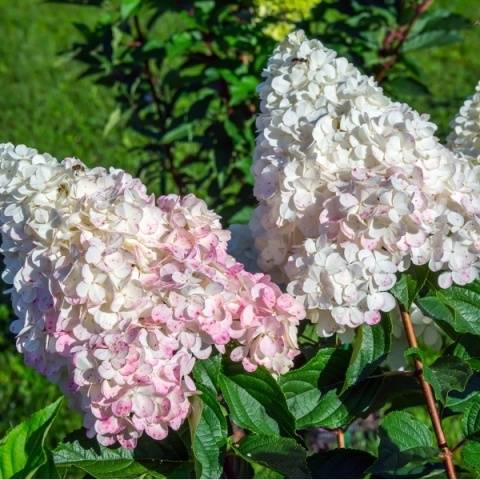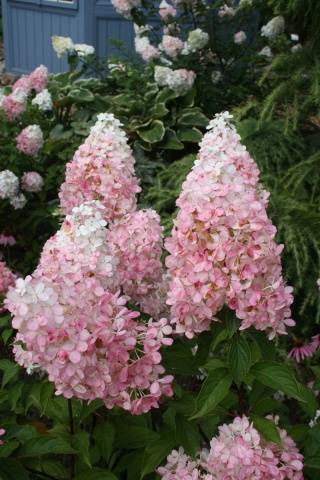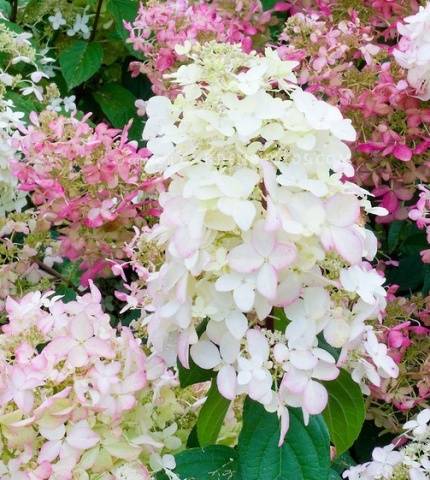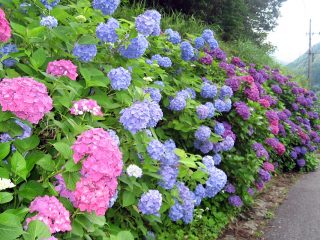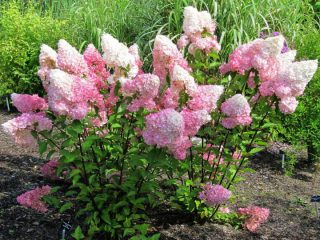Content
The panicle hydrangea is an excellent option for decorating a recreation area, home gardens and parks. Pink Lady is a popular variety that stands out for its lush white-pink inflorescences. With proper planting and care, a shrub with excellent decorative properties can be grown.
Botanical description
The Pink Lady panicle hydrangea is bred by the Dutch breeder Peter Zweinenburg. Work on the variety was carried out in the 70s and 80s of the XX century. The variety has been highly praised by the Royal Horticultural Society of Great Britain. Pink Lady is recognized as one of the most sought after varieties of panicle hydrangea.
Description of Pink Lady hydrangea:
- fan-shaped shrub 1.5-2 m high;
- large, conical inflorescences, 25-30 cm long;
- leaves are oval, bright green, jagged at the edges.
Due to the powerful shoots, the bushes retain their shape during flowering. Leaves are located along the entire length of the branches. Flowering begins in mid-July and ends in September.
At the beginning of flowering, the brushes of the shrub consist of small white flowers with a graceful and airy appearance. When the flowers bloom, the panicles become denser.
Hydrangea flowers Pink Lady consist of 4 petals, have a rounded shape. During the season, the petals acquire a pale pink color.
Subject to the rules of planting and care, the Pink Lady panicle hydrangea has been growing in one place for several decades. The shrub is used to design single plantings, mixborders and hedges.
Hydrangea looks spectacular against the background of a green lawn. In mixed plantings, it is planted next to other ornamental shrubs.
Planting hydrangeas
The plant must be planted in a prepared place. A substrate is preliminarily prepared, taking into account the characteristics of the soil. When choosing a site, its illumination and the presence of protection from the wind are taken into account.
Preparatory stage
The Pink Lady panicle hydrangea is best planted on the south side of the site. In hot regions, the shrub is located in partial shade. With constant exposure to the sun, the decorative properties of the inflorescences are lost.
When planted next to a fence or a building, the shrub will receive the necessary partial shade and protection from the wind. It is placed away from fruit trees, which take many nutrients from the soil.
Abundant flowering is ensured by planting the plant in fertile loamy soil. Heavy clay soils are fertilized with humus. Nutrients are quickly washed out of the sandy soil, so peat and compost are added to it.
Hydrangea is demanding on the acidity of the soil. The shrub grows well in a neutral and slightly acidic substrate. When digging up the earth, you should abandon the use of chalk, dolomite flour, lime and ash.
Work order
Panicle hydrangea is transferred to open ground in early spring before the start of sap flow. The work can be postponed until autumn. Then the planting of the shrub is carried out in September or October after leaf fall.
Seedlings of the Pink Lady variety are purchased from nurseries or from trusted suppliers. Typically, planting material is sold in containers with a closed root system. A healthy plant has no signs of decay, dark spots, cracks or other defects.
Sequence of planting works:
- At the chosen place, a hole is dug with a diameter of 30 cm and a depth of 40 cm.
- The substrate for the Pink Lady variety is obtained by mixing fertile soil, peat and humus.To deoxidize the soil, coniferous litter is added.
- Then the pit is filled up with the substrate and left for 1-2 weeks. When the soil settles, they begin to prepare the seedlings for planting.
- The roots of the plant are cut. The use of a growth stimulant helps to improve the survival rate of the seedling. The roots of the plant are immersed in the solution for 2 hours.
- Hydrangea is planted in a permanent place, the roots are straightened and covered with earth.
- Plants are watered abundantly with soft water.
After planting, caring for the Pink Lady paniculate hydrangea includes regular watering. To protect from the sun in the heat, the plants are covered with paper caps.
Hydrangea care
The Pink Lady strain provides constant grooming. This includes watering, feeding, pruning a bush. To protect shrubs from diseases and pests, special preparations are used. In colder regions, hydrangeas are prepared for winter.
Watering
According to the description, the Pink Lady hydrangea is moisture-loving. The development of the shrub and the formation of inflorescences depend on the intake of moisture.
On average, Pink Lady is watered every week. Watering rate - up to 10 liters for each bush. It is important not to allow the soil to dry out. In drought, moisture is introduced more often, up to 2-3 times a week.
For watering hydrangeas, use warm, settled water. The procedure is carried out in the morning or in the evening. Water should not come into contact with shoots, leaves and inflorescences.
So that the roots of the shrub are not exposed during watering, the soil is mulched with peat or humus. Mulching helps to retain moisture in the soil.
Top dressing
Another condition necessary for the abundant flowering of hydrangeas is the intake of nutrients. For feeding the Pink Lady variety, both organic matter and mineral complexes are used. It is best to alternate between different types of dressings.
The Pink Lady panicle hydrangea is fed according to the scheme:
- in the spring before bud break;
- when the first buds appear;
- in the middle of summer;
- in the fall after the end of flowering.
The first feeding is carried out using organic fertilizers. For this, a slurry solution is prepared in a ratio of 1:15. The resulting fertilizer is watered at the root of the bushes.
In summer, hydrangea is fed with mineral complexes. The fertilizer is prepared independently by dissolving 35 g of ammonium nitrate, 20 g of superphosphate and potassium salt in 10 liters of water.
There are ready-made mineral complexes designed specifically for hydrangea. Such preparations are in the form of granules or suspensions. Fertilizers are dissolved in water, after which watering is performed.
In autumn, 50 g of superphosphate and potassium salt are added to the soil under the Pink Lady bushes. Substances containing nitrogen are not used in the autumn.
Pruning
To obtain large inflorescences, hydrangea is pruned. In the spring, before the start of sap flow, the shoots are shortened, 6-8 buds are left.
Be sure to remove weak, broken and diseased shoots. In total, it is enough to leave 5-10 powerful branches per bush.
A short pruning helps to rejuvenate the old bush. All branches are cut out at the root, 10-12 cm from the ground are left above the ground. New shoots will appear next year.
In summer, the Pink Lady hydrangea is not pruned. It is enough to remove dry inflorescences to stimulate the formation of new buds.
Protection against diseases and pests
In cold and wet weather, panicle hydrangea is susceptible to fungal diseases. Most often, the shrub suffers from powdery mildew. The lesion has the appearance of a whitish bloom that appears on shoots and leaves.
For powdery mildew, use the fungicide Topaz, Quadris or Fundazol. On the basis of the drug, a solution is prepared with which the bushes are sprayed. Processing is carried out in the morning or evening.
Insecticides Aktofit, Fitoverm, Trichopol are used against aphids. Hydrangea is treated with a solution on a leaf.
To prevent the spread of pests, folk remedies are used. The shrub is sprayed with an infusion of garlic or onion skins.Such preparations are completely safe for plants and humans, therefore they are used at any stage of the growing season.
Shelter for the winter
The Pink Lady variety is characterized by increased winter hardiness. The shrub tolerates frosts down to - 29 ° С. In the middle lane and southern regions, hydrangea winters without shelter.
In cold winters, in the absence of snow cover, the roots of the shrub are mulched with humus and dry leaves. The optimal mulch thickness is from 20 to 30 cm.
Young plants are insulated with burlap or agrofibre. Additionally, a snowdrift is thrown over the bushes.
Gardeners reviews
Conclusion
Hydrangea Pink Lady has received worldwide recognition. It is used to decorate gardens and parks. The shrub is appreciated for its decorative properties, easy maintenance and endurance. The hydrangea is regularly looked after in order to achieve a long flowering shrub.
